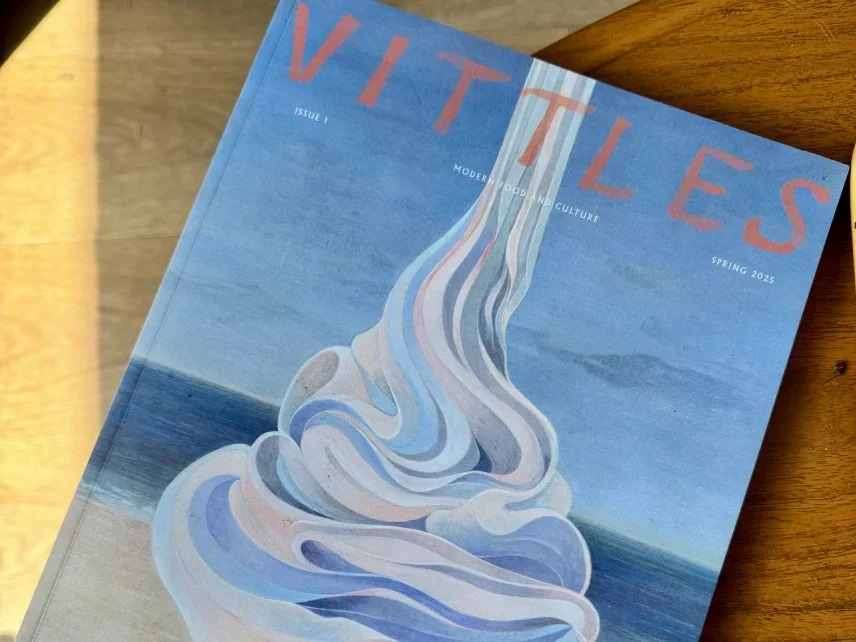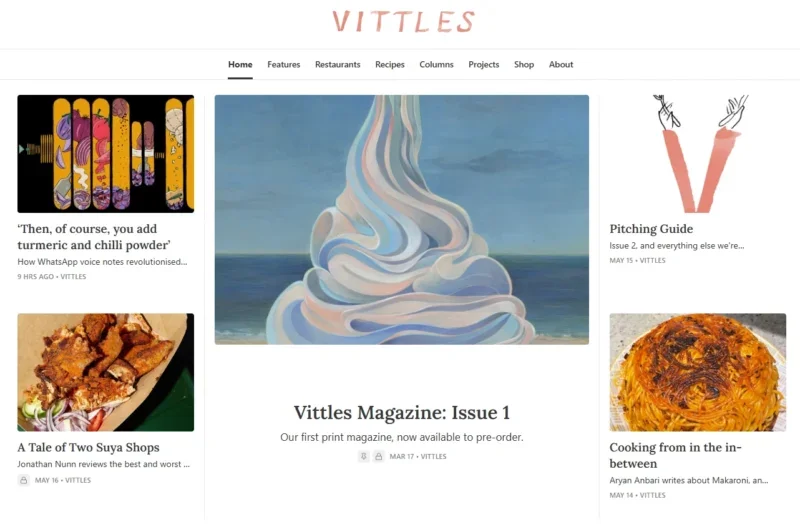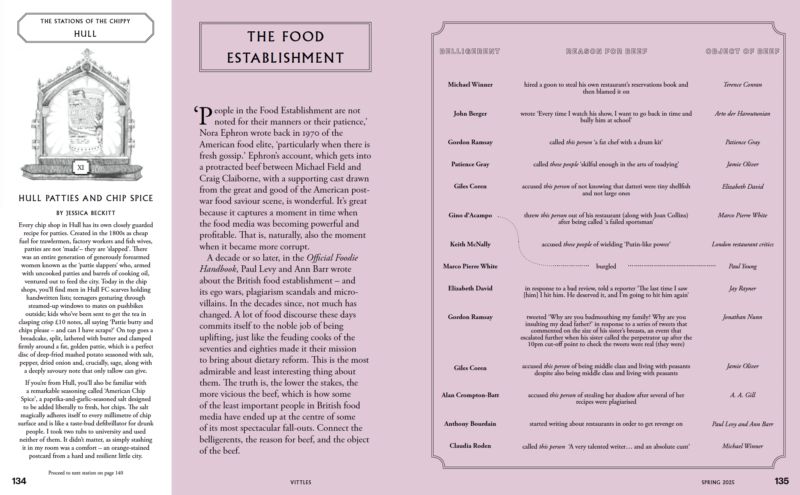
The first time Vittles founder Jonathan Nunn read a food magazine was in 2015, in a New York cafe whose coffee table was supporting a stack that included the now-defunct Lucky Peach.
“I opened it, and there was an article about a mithai shop about five minutes away from my childhood home in Bounds Green. And I was utterly floored that an American magazine would’ve chosen to publish an article about a shop in London that was so everyday to me, but treat it as if it was something quite special,” says Nunn.
“Reading that was a real shift in how I thought about London, and London restaurants, and the way something becomes important. If it’s written down, and written down on paper as well. That was very influential on how I started to write. I do think objects like that can change culture in a way that it’s harder to do over email.”
Five years later, in March of 2020, Nunn launched Vittles, “a new food newsletter for novel times,” on Substack. By Christmas of the same year, it was going well enough that one fan felt compelled to print out and staple together issues of the newsletter to make their own Vittles print magazine of sorts, and send it to Nunn.
By 2022, Nunn was being profiled in The Guardian and the New Statesman, and could count Nigella Lawson among his tens of thousands of subscribers. By 2023, he was being profiled in The New Yorker, slagged off in the New Statesman, and could count more than 40,000 subscribers alongside Nigella, with roughly a tenth of those paying for the full subscription.
And then near the end of last year, with his subscriber count still steadily growing toward its current peak of 84,000, and a tenth of those paying £7/month or £59/year (suggesting annual revenue in excess of £400,000 after commissions Substack fees), Nunn and his team felt that, finally, they were ready to hit print.

“When I started Vittles,” says Nunn, explaining his caution, “if people pitched something that wasn’t quite right for us, I’d always know where to tell them to go. There would always be somewhere. A lot of those places aren’t there anymore, and for the most part it’s because they expanded too quickly. So I didn’t want to jeopardise the whole operation by going into print too early because of a misplaced sense of prestige.
“I don’t think it is, or should be, more prestigious than having a good online company. It’s more about how we can add to what we do online in a way that feels intellectually interesting, and maybe that could’ve been audio or video if we were good at that, but we’re all editors and writers, so it felt right to go back to the printed word.”
When the decision to go into print was finally made, around six months ago, Team Vittles were torn about whether it would be a longer-term commitment or just a one-off. For the first three months of the process, “issue one” was not “issue one”, but “issue zero”. (“Because ‘issue one’ is committing to more issues,” Nunn explains.)
They’d seen the upfront costs associated with print, and weren’t convinced the magazine could be anything more than an occasional, loss-making pet project. But as they stayed on schedule, and didn’t go over budget, and didn’t find any hidden costs, Nunn decided they should commit. Issue one is now profitable and the first meeting for issue two – which will be themed around “bad food” – was last week. Priced at £20 per copy, Vittles is promising to be published twice a year.
There were several reasons for taking the leap. One was that the newsletter had enough financial stability to cross-subsidise any potential losses. Another was a sense that people – more people than just one hyper-dedicated fan in Christmas of 2020 – wanted to hold a Vittles magazine in their hands.
“I just thought that surely if I get this slightly immiserating feeling from being on my phone constantly, and have to experience writing through my phone or at best my laptop, then maybe other people feel the same way,” says Nunn. “I think print is now countercultural, because the dominant culture is online.”
Beyond this was a desire to create something that will last. Nunn is characteristically careful around words like “prestige” and “legacy”, but he says spending a lot of time in archives has made him appreciate “that sense of something being a body of work, where all these things have a relationship with each other, and it’s archivable. That feels significant to me. I do hope that someone might pick up a copy of Vittles in the British Library in 30 or 40 years’ time and be like ‘oh, that’s what was going on in those five years in food writing’, in a way that might be quite difficult to do if it was just in peoples’ inboxes.”
But more than all of this – that they could afford it, that people wanted it, that it would cement their legacy – Nunn wanted to make a magazine because making magazines is fun. What’s fun about it? “What isn’t fun about it? You have a blank page, and you fill it up, in whatever way you want – with words, images, designs, and all these things can interact and bleed into each other in very interesting ways,” he says.
“Suddenly you’re only limited by your imagination. You’re not limited by how the back end of a website works. You can do anything.”

If they’d gone with the issue zero idea, the magazine would’ve been a sort of greatest hits compilation of the best pieces published over five years of being online. Indeed, half of issue one is this – but the other half is original writing, and Nunn says 100% of all subsequent issues, which will come out twice a year and each have their own theme, will be new and exclusive to print.
He’s now started thinking about what they can do online that they couldn’t do in print, and vice-versa. When pitches come in, they’ll have to think about whether this is an idea for the magazine or the newsletter. Vittles is starting to sound like a very grown-up operation indeed.
You might think, given the trepidation with which he’s approached the whole thing, that this was all part of some carefully-calibrated long-term plan on Nunn’s part. And he seems like a man who plans – they decided how many issues of the magazine to print (5,000) only after seeing how many were pre-ordered on their website (2,500), and though a second print run is tempting, Nunn likes the idea of leaving people wanting the next one.
He’s cognisant of “the issue two dip – people always print too many,” and when I ask whether he feels part of an emerging print magazine movement (alongside fellow youthful, literary-leaning publications like The Fence), he says “once we’re working on issue two, then maybe. I would like to be part of it.” He asks for his image not to be used in this article, and several times as we’re speaking he glances down at the phone I’m recording him on, and seems to pause and select his words accordingly.
But when the question of any goals he might have for the magazine comes up, Nunn regards the word with a bemused disdain. “I’ve never had a goal,” he says. “Like, ever. I’ve never had a five year plan or anything. What Vittles is now would’ve been baffling to me when I started. Hopefully the same will be true in ten years.
“My aim for issue one is that people enjoy it, and people really love it and find it beautiful as an object, and connect with it in a way that they might not have done if it was in their inbox. I hope it introduces new people to us in a way that the online part of the magazine can’t. I hope it doesn’t bankrupt us. Those are my main aims.”
Email pged@pressgazette.co.uk to point out mistakes, provide story tips or send in a letter for publication on our "Letters Page" blog
